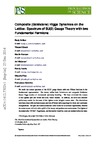Composite (Goldstone) Higgs Dynamics on the Lattice: Spectrum of SU(2) Gauge Theory with two Fundamental Fermions
| dc.contributor.author | Hietanen, A | |
| dc.contributor.author | Arthur, R | |
| dc.contributor.author | Drach, V | |
| dc.contributor.author | Hansen, M | |
| dc.contributor.author | Lewis, R | |
| dc.contributor.author | Pica, C | |
| dc.contributor.author | Sannino, F | |
| dc.date.accessioned | 2018-07-25T15:00:46Z | |
| dc.date.available | 2018-07-25T15:00:46Z | |
| dc.date.issued | 2015-05-21 | |
| dc.identifier.issn | 1824-8039 | |
| dc.identifier.uri | http://hdl.handle.net/10026.1/11909 | |
| dc.description | 7 pages, 5 figures, talk presented at The 32nd International Symposium on Lattice Field Theory, June 23-28, 2014, Columbia University, New York | |
| dc.description.abstract |
We study the meson spectrum of the SU(2) gauge theory with two Wilson fermions in the fundamental representation. The theory unifies both Technicolor and composite Goldstone Boson Higgs models of electroweak symmetry breaking. We have calculated the masses of the lightest spin one vector and axial vector mesons. In addition, we have also obtained preliminary results for the mass of the lightest scalar (singlet) meson state. The simulations have been done with multiple masses and two different lattice spacings for chiral and continuum extrapolations. The spin one meson masses set lower limits for accelerator experiments, whereas the scalar meson will mix with a pGB of the theory and produce two scalar states. The lighter of the states is the 125 GeV Higgs boson, and the heavier would be a new yet unobserved scalar state. | |
| dc.format.extent | 249- | |
| dc.language.iso | en | |
| dc.publisher | Sissa Medialab | |
| dc.subject | 5106 Nuclear and Plasma Physics | |
| dc.subject | 5107 Particle and High Energy Physics | |
| dc.subject | 4902 Mathematical Physics | |
| dc.subject | 49 Mathematical Sciences | |
| dc.subject | 51 Physical Sciences | |
| dc.title | Composite (Goldstone) Higgs Dynamics on the Lattice: Spectrum of SU(2) Gauge Theory with two Fundamental Fermions | |
| dc.type | conference | |
| dc.type | Conference Proceeding | |
| plymouth.author-url | http://arxiv.org/abs/1412.7302v1 | |
| plymouth.date-start | 2014-06-23 | |
| plymouth.volume | Part F130500 | |
| plymouth.conference-name | The 32nd International Symposium on Lattice Field Theory | |
| plymouth.publication-status | Published | |
| plymouth.journal | Proceedings of The 32nd International Symposium on Lattice Field Theory — PoS(LATTICE2014) | |
| dc.identifier.doi | 10.22323/1.214.0249 | |
| plymouth.organisational-group | /Plymouth | |
| plymouth.organisational-group | /Plymouth/Faculty of Science and Engineering | |
| plymouth.organisational-group | /Plymouth/REF 2021 Researchers by UoA | |
| plymouth.organisational-group | /Plymouth/REF 2021 Researchers by UoA/EXTENDED UoA 10 - Mathematical Sciences | |
| plymouth.organisational-group | /Plymouth/REF 2021 Researchers by UoA/UoA10 Mathematical Sciences | |
| plymouth.organisational-group | /Plymouth/Users by role | |
| plymouth.organisational-group | /Plymouth/Users by role/Academics | |
| dc.identifier.eissn | 1824-8039 | |
| dc.rights.embargoperiod | No embargo | |
| rioxxterms.versionofrecord | 10.22323/1.214.0249 | |
| rioxxterms.licenseref.uri | http://www.rioxx.net/licenses/all-rights-reserved | |
| rioxxterms.type | Conference Paper/Proceeding/Abstract |


